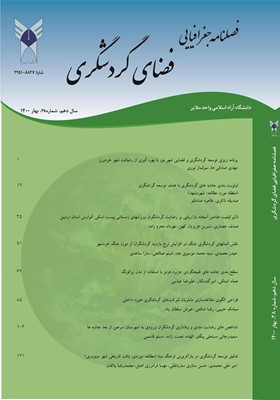طراحی الگوی متقاعد سازی مشتریان شرکت های گردشگری حوزه داخلی
محورهای موضوعی : مربوط به گردشگریسیامک حبیبی 1 , رضا شافعی 2 , هیرش سلطان پناه 3
1 - دانشجوی دکتری مدیریت، واحد سنندج، دانشگاه آزاداسلامی، سنندج، ایران
2 - دانشیار گروه مدیریت بازرگانی، دانشکده علوم انسانی و اجتماعی، دانشگاه کردستان و پژوهشگر پژوهشکده کردستان شناسی
3 - استادیار گروه مدیریت، واحد سنندج، دانشگاه آزاداسلامی، سنندج، ایران
کلید واژه: وفاداری, اعتماد, تعهد, گردشگری, رضایت مندی, متقاعد سازی,
چکیده مقاله :
بازاریابی برای آژانس های گردشگری از طریق فروش و جذب و حفظ گردشگران بسیار مهم و اساسی است. به دلیل اهمیتی که فروش برای آژانس های گردشگری دارد به کارگیری تکنیک های متقاعد سازی گردشگران برای آژانسها از اهمیت ویژهای برخوردار است. متقاعدسازی ریشه در مباحث روانشناسی اجتماعی دارد و دارای تکنیکهای متعددی است که هرکدام دارای تأثیر ویژهای در متقاعدسازی مشتری دارند. هدف از این پژوهش طراحی الگوی پارادایمی مبتنی بر تکنیکهای متقاعدسازی مشتریان در حوزه گردشگری است. با توجه به اینکه روش انجام این پژوهش کیفی است در مرحله نخست با استناد به کتابها و مقالات موجود در حوزه بازاریابی و گردشگری مبانی نظری پژوهش گردآوری شد و در مرحله بعد با مصاحبه باز نظرهای خبرگان حوزه گردشگری که شامل استادان رشته بازاریابی، سازمان میراث فرهنگی و گردشگری و مدیران دفاتر گردشگری بود جمعآوری شد که با استفاده از نرم افزار MAXQDA 2020 مورد تجزیهوتحلیل قرار گرفت. یافته های پژوهش منجر به شناسایی 596 کد اولیه 28 مقوله فرعی و 11 مقوله محوری گردید. نتایج این پژوهش درنهایت منجر به طراحی الگوی پارادایمی متقاعد سازی مشتریان شرکت های گردشگری بر اساس تکنیک ها و اصول متقاعد سازی و پیامدهای آن بر رفتار مشتریان گردید.
Marketing is very important for travel agencies by attracting and retaining tourists. Due to the importance of selling products to tourism travel agencies, the use of customer persuasion techniques for these companies will also be of particular importance. Persuasion is rooted in social psychology topics with a variety of techniques, each of which has a particular impact on customer persuasion. The purpose of this study is to design a paradigm model based on customer persuasion techniques in the field of tourism Due to the fact that the method of this research is qualitative, in the first stage, the theoretical foundations of the research were collected by referring to books and articles in the field of marketing and tourism. In the next stage, the opinions of tourism experts were collected through open interviews, which included professors of marketing, cultural heritage and tourism organization, and managers of tourism offices, which were analyzed using MAXQDA 2020 software. The research findings led to the identification of 596 initial codes of 28 sub-categories and 11 central categories. The results of this study ultimately led to the design of a paradigm model of convincing customers of tourism companies based on the techniques and principles of persuasion and its consequences on customers' behavior.


